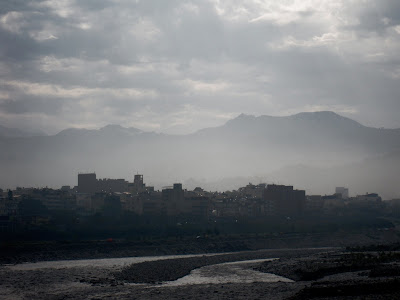 SiMa XianShan
SiMa XianShan
The hardest single hill climb I have ever done was this route up the Da An River. I had been thinking about this trip for a while as it is one of my favorite places in Taiwan. Just outside of Juolan in central Taiwan there is a road that parallels the Da An River. It is a gorgeous ride up into some Atayal villages.
The first time I went up there I was looking for the route a group of Pazih (Pazeh) speaking people used to cross into the Puli basin in the 19th Century. One of my 96 year-old Pazih contacts recalled the story of how her great grandfather packed up the family from near the Nei She area below the Long Teng Broken Bridge to join other Pazih speakers in Ailan. Some of the family remained in the area and have since forgotten their Pazih ancestry and have become "Ex-Aborigines". My Pazih friend knew her family had hiked into Puli, but didn't know from where. I figured the Da An river was a good candidate for the route out of Juolan.
Up the Da An river there are a handful of villages primarily inhabited by Atayal speakers. The mountains rise up right out of the river and the sense of "wow!" can quickly overtake you. You can pass Elephant Nose village and go on to the bridge under Sky Dog village. What might not be apparent is that you are sitting right in the line of fire of Japanese light artillery.
During the first 40 years of the Japanese colonial period in Taiwan (1895-1935), the Japanese administration set out to "pacify and subdue" the highland indigenes who inhabited the mountains of
central Taiwan. Much of the impetus for this was colonial in nature, in the repetitive cycle of the government continually seeking to exploit the resources the indigenous people seek to retain. We are seeing this phenomenon again in the aftermath of Typhoon Morikot as the Ma administration seeks to remove indigenous peoples from their current homes and move them into new homes outside their traditional and commercially viable locations.
After several years of combat the Japanese succeeded in installing several artillery pieces on several strategic mountainsides to better control the indigenous peoples. From the installation on the mountain above, the Japanese had control over the three valleys below. The remains of the base are not entirely visible at first, but if you inspect the site a little more the trench works, barracks, and gun emplacements come into view. It wasn't quite The Guns of Navarone, but it is easy to imagine the area as a military outpost on a colonial frontier.
When I did this ride I arrived at the base of SiMa XianShan and started my climb. The road keeps rising up with some serious sections of steep ascents. There are a few mellow areas where you can catch your legs, but then the road takes off again. Sky Dog (Tian Gou) village makes a good place to hydrate. They seem to be trying to turn it into a tourist village, but there is still a lot to do. It was a rough, rough climb. I finally got to the top to find a bunch of mountain bike riders playing on the trails. They had all driven up the back side in cars. Bastards! I chatted them up for a while until the idea to continue up hill another 300 meters to the Japanese base. It would have made for great pictures, but I wanted to start my descent.

For this ride I put on my 32c fast dirty tires because the roads had been washed out on prior trips. The descent goes alog a cliffside road through tall cedars before going back to the jungle. The road is a little slick with light debris over the pavement and some steep descents where the braking gets technical. The rule of thumb is to stay right at every intersection if it is unmarked. It will spit you out into Dahu. The climb takes you 1640ft. from the river to the peak.
I hit the Highway 3 home, but I forgot about all the long, rolling hills on the way back. I rode embarrassingly slow as I lost time and hours of daylight. At the top of the hill over Juolan I took the LiYu Tan Rd. over the south side of the reservoir. I love this road, but I was too beat to enjoy it. I finally limped back to Feng Yuan on the 13, which has one last annoying hill at the end. It took me way too long, but not a bad ride at all.










































